|
|
An Egyptian Lector Priest, Etruscan
Griffins and a Roman Gladiator
|
The lector priest Idu was an important personality from the entourage of a pharaoh of the 6th dynasty. He contributed to ceremonies with chanting and prayers, but was also called for private apotropaic cults of the royal family. Today the magnificent limestone relief still reminds us of him, which we are happy to present as our highlight of the month. Exceptional is also the rare Etruscan stair slab relief with its griffins and mixed creatures. The iconography of the Italic sculptors remains unique to this day. But size does not necessarily matter to be significant. The Roman solid bronze statuette of a murmillo measures only 7.6 cm, but it has the expression of a major artwork. See for yourself with a visit in our showroom from 10 February!
|
|
Ein ägyptischer Vorlesepriester, etruskische Greifen und ein römischer Gladiator
|
Der Vorlesepriester Idu etwa war einst eine bedeutende Persönlichkeit aus dem Umkreis eines Pharaos der 6. Dynastie. Er begleiteten Zeremonien mit Gesängen und Gebeten, wurde aber auch für private apotropäische Kulte des Königshauses herangezogen. Heute erinnert noch das prachtvolle Kalkstein-Fragment an ihn, das wir als unser Highlight des Monats vorstellen dürfen. Herausragend ist auch das seltene etruskische Treppensteinrelief mit seinen Greifen und Mischwesen. Die Ikonographie der italischen Bildhauer blieb bis heute einzigartig. Doch es geht auch kleiner, um bedeutend zu sein. Die römische Vollbronze-Statuette des Murmillos misst nur 7,6 cm, doch sie hat die Ausdruckskraft eines ganz Großen. Überzeugen Sie sich selbst bei einem Besuch in unserem Showroom ab 10. Februar!
|
|
|
|
Our Highlight of the Month:
|
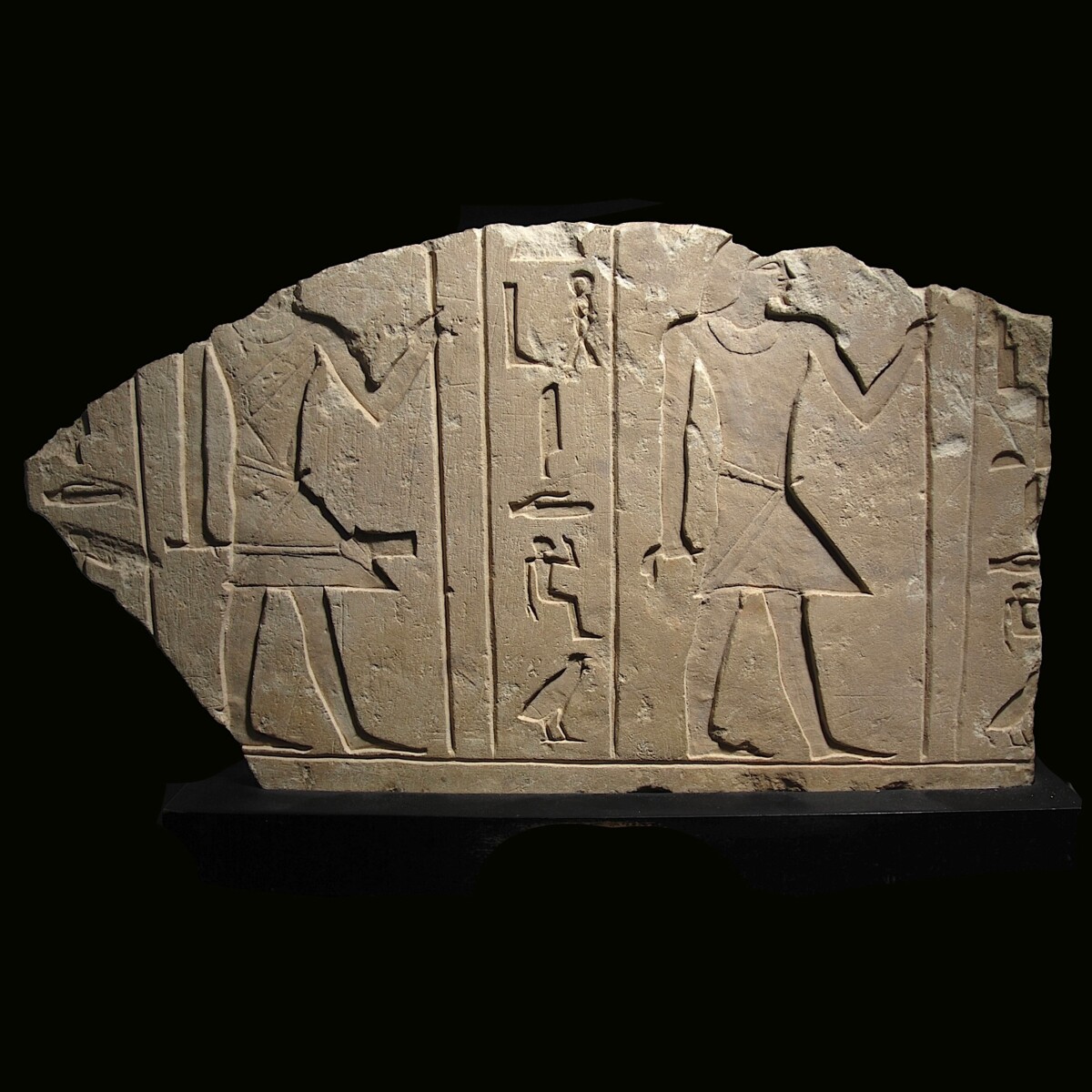
|
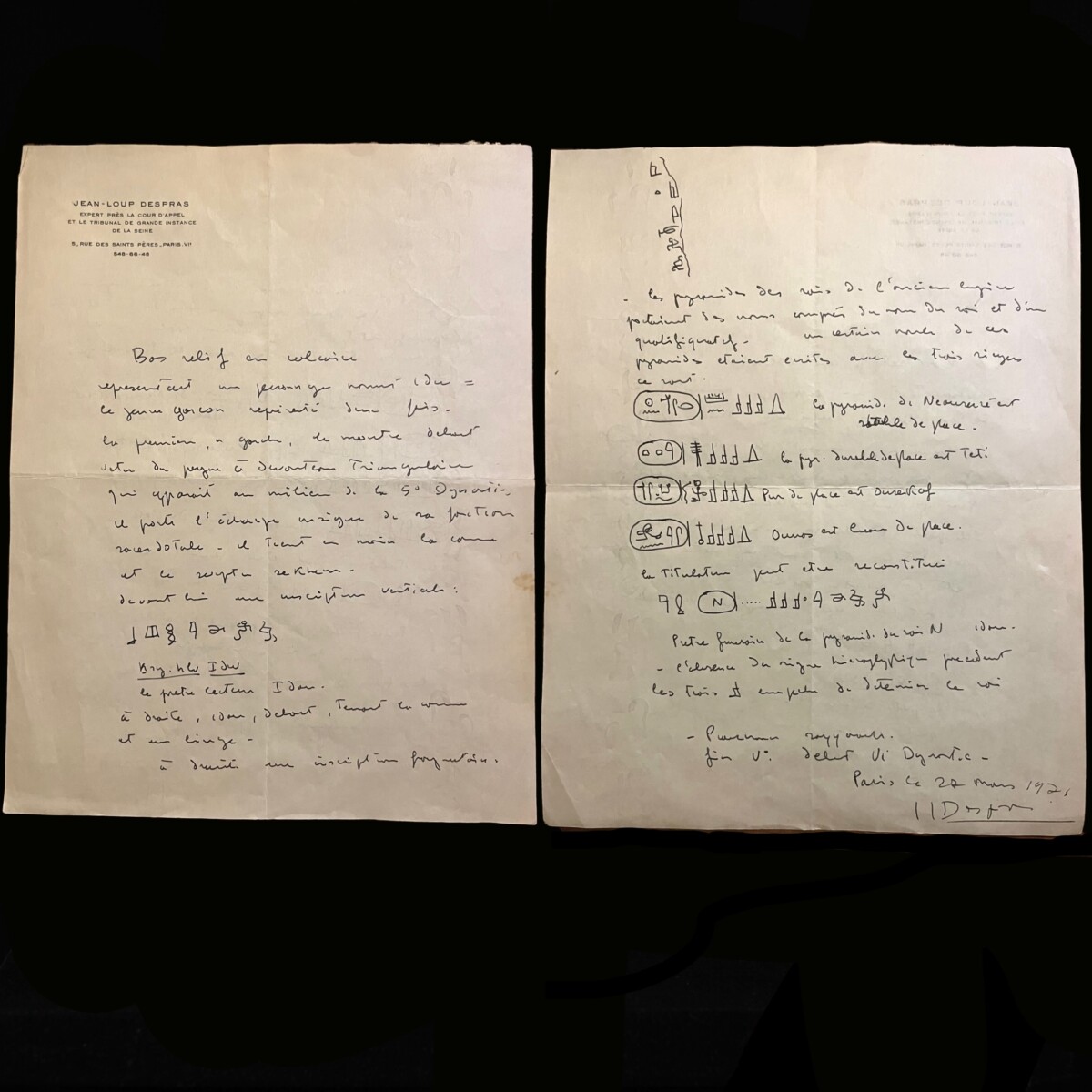
|
|
|
|
Egypt – Old Kingdom, 6th dynasty, 2347-2216 B.C.
|
Large limestone relief from the Old Kingdom mentioning the name of the lector scribe Idu. Idu himself is depicted twice standing to the right. This in a row depiction of a tomb owner only emerges in the early 6th dynasty, which is why a very precise dating of the relief is possible. In both depictions he wears a neck collar and an apron knotted on his stomach, which ends above his knees and protrudes triangularly at the front. In his left hands he holds a staff. In the rear depiction he holds a sekhem sceptre in his right hand, a symbol of power in form of a baton, which is known since the Old Kingdom. He has a sash tied around his upper body. In the front depiction he holds a cloth with his hanging right hand. The figures are separated by very finely worked out vertical hieroglyphic inscriptions. They mention the name Idu and the title “lector priest”, a high-ranking position, which was known in ancient Egypt as “Cheri-hebet”. Lector priests accompanied funerary ceremonies with chanting, prayers and litanies, but were also asked for private apotropaic cults. Today there are more than 20 known persons with the name Idu from the Old Kingdom. Anyway, Idu of the present relief is so far unknown, he is probably a priest for the death cult of a pyramid complex. From Giza. Mounted.
|
Provenance: French private collection Jean Deriat (1922-2016) acquired 1971. With the original certificate by Jean-Loup Despras from the gallery Orient-Occident, dated 27 March 1971. Thence in a family estate. Accompanied by a French antiquities passport.
Dimensions: 44 cm x 24 cm
Price: 32 000 Euro
|
|
|
Ägypten – Altes Reich, 6. Dynastie, 2347-2216 v. Chr.
|
Großes Kalksteinrelief aus dem Alten Reich, das den Namen des Vorlesepriesters Idu nennt. Idu selbst ist zweimal stehend nach rechts dargestellt. Diese reihenhafte Darstellung eines Grabherren taucht erst in der frühen 6. Dynastie auf, weshalb eine sehr präzise Datierung des Reliefs möglich ist. Er trägt in beiden Darstellungen einen Halskragen und einen am Bauch verknoteten Schurz, der über den Knien endet und vorne dreieckig wegsteht. In seiner linken Hand hält er jeweils einen langen Stab. Die hintere Darstellung zeigt ihn mit einem Sechem-Zepter in der rechten Hand, einem Machtsymbol in Form eines Kommandostabs, das seit dem Alten Reich belegt ist. Um den Oberkörper hat er eine Schärpe gebunden. In der vorderen Darstellung hält er in der herabhängenden rechten Hand ein Tuch. Die Figuren sind von besonders fein gearbeiteten, vertikalen Hieroglyphen-Inschriften getrennt. Sie nennen den Namen Idu und den Titel „Vorlesepriester“, ein hohes Amt, das altägyptisch als „Cheri-hebet“ bezeichnet wurde. Vorlesepriester begleiteten Begräbniszeremonien mit Gesängen, Gebeten und Litaneien, wurden aber auch für private apotropäische Kulte herangezogen. Der Name Idu ist heute über 20 Mal belegt. Der Idu dieses Reliefs ist bisher unbekannt, es handelt sich wohl um den Priester für den Totenkult einer Pyramidenanlage. Aus Gizeh. Gesockelt.
|
Provenienz: Französische Privatsammlung Jean Deriat (1922-2016), erworben 1971. Mit Originalzertifikat von Jean-Loup Despras von der Galerie Orient-Occident, datiert mit 27. März 1971. Danach in Familienbesitz. Mit französischem Antikenpass.
Dimensionen: 44 cm x 24 cm
Preis: 32.000 Euro
|
|
|
|
Selected Artworks of the Month:
|
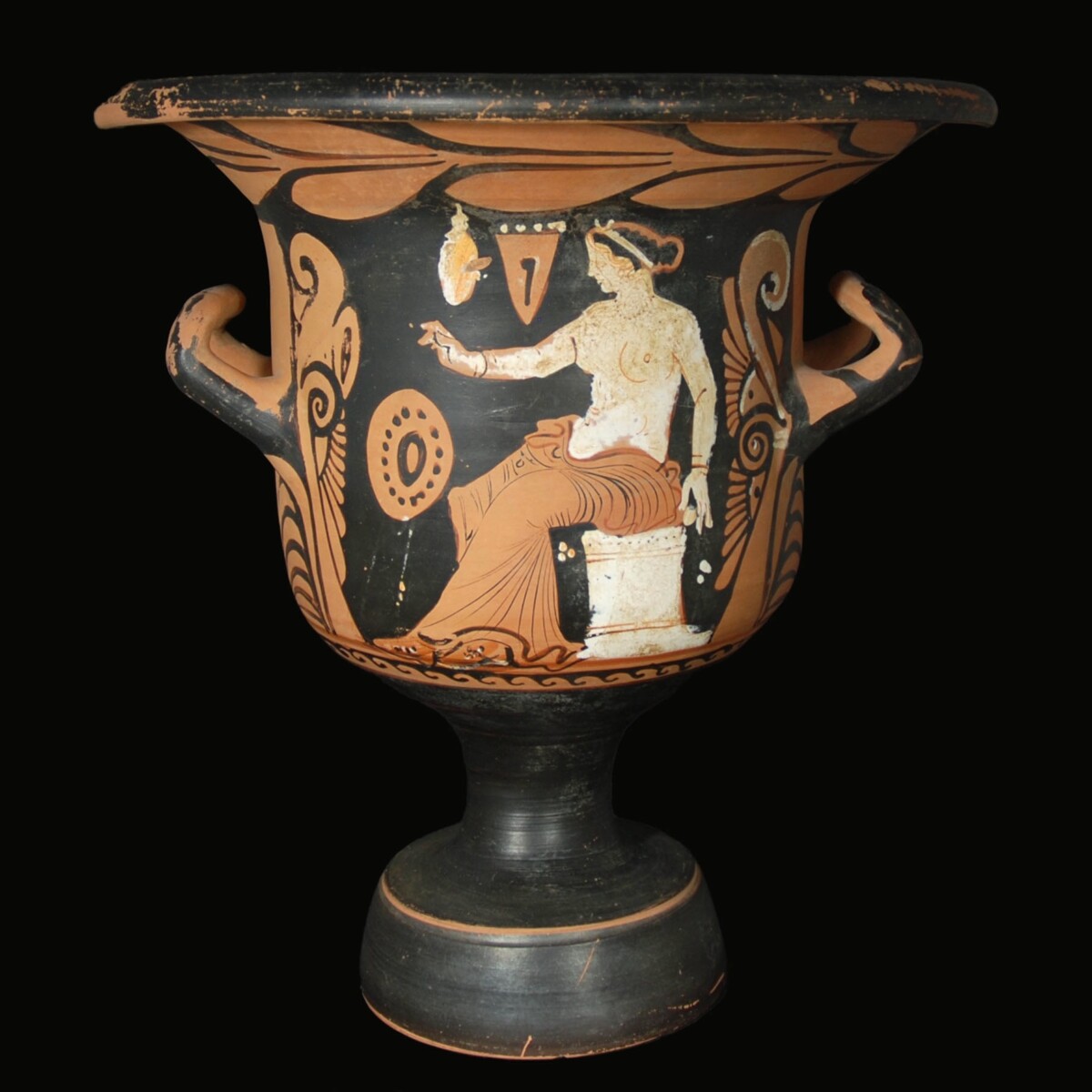
|
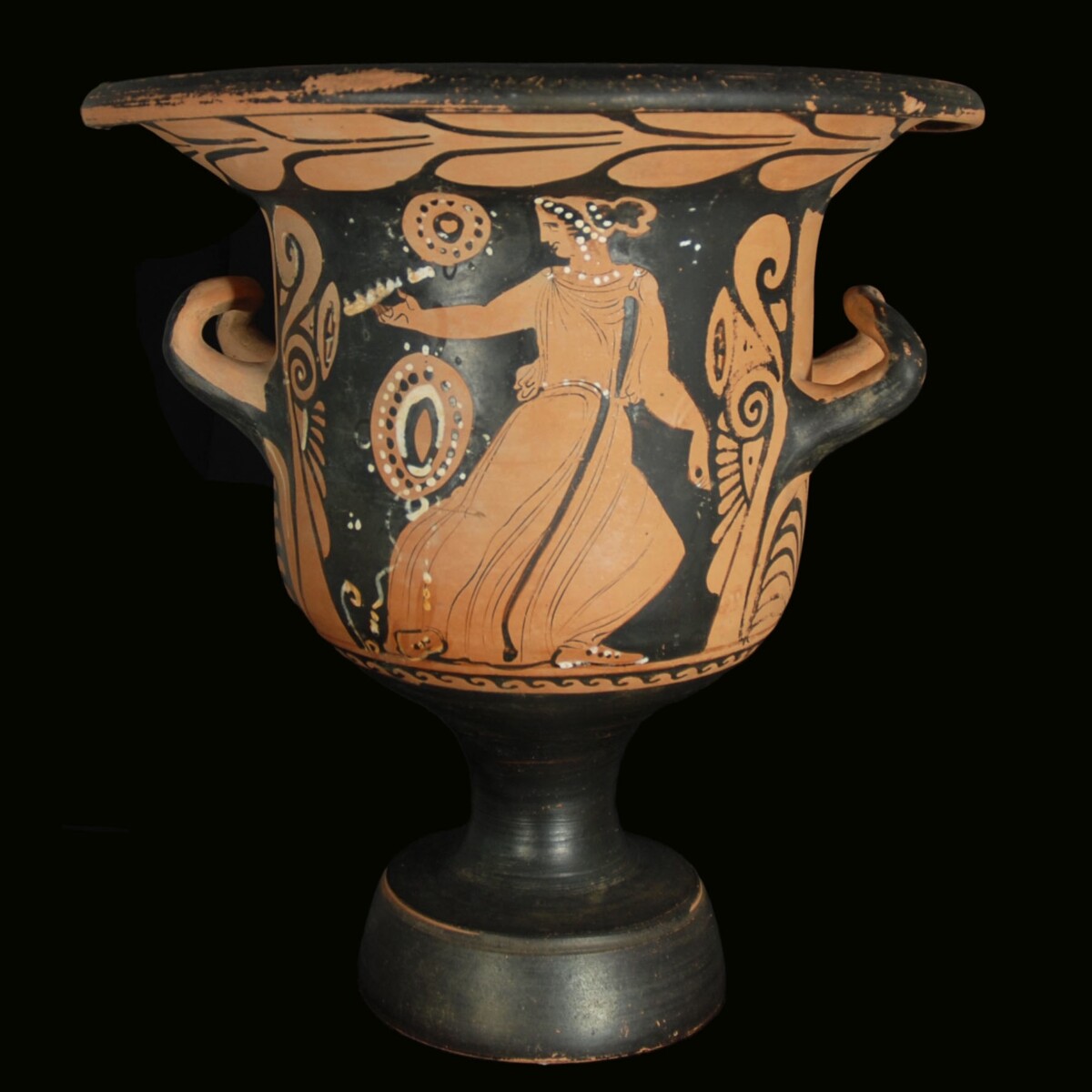
|
|
|
|
Greece/Paestum – 330-320 B.C.
|
Large red-figure bell krater on a high ring foot from the workshop of the Naples Painter 2585 in Paestum. The front depicts a magnificent and rare depiction of a noble woman facing to the left with a bare upper body. The noble, white skin tone is applied with opaque white, details such as hair and folds are in yellow. The lady is seated on a column base, she wears a necklace and bracelets. Her gown flows around her hips and legs, belly and navel are visible. She stretches her left arm forward, between hand and knee a tambourine (“tympanon”). The other side depicts a woman dancing to the right, possibly a maenad or servant, she looks back and holds in her stretched-out hand a phiale. Above and below more tambourines. The image scenes are lined at the bottom with a black wavy band. Above, below the far protruding rim, encircling laurel leaves. The opposite handles are curved upwards, below the handles large-scale palmettes. For the Naples Painter 2585 see: A. D. Trendall “The Red-Figured Vases of Paestum”, British School of Rome, 1987, pages 302 ff.
|
Provenance: British collection David Gibson prior to 2000. Thence auctioned with Christie's London on 15 May 2002, lot 438. There acquired by the gallery Chenel and sold to an English collector. Last in the English art market.
Dimensions: 41.8 cm high
Price: 18 000 Euro
|
|
|
Griechenland/Paestum – 330-320 v. Chr.
|
Großer rotfiguriger Glockenkrater auf hohem Standfuß aus der Werkstatt des Malers von Neapel 2585 in Paestum. Die Vorderseite zeigt eine ebenso prachtvolle wie seltene Darstellung einer nach links gerichteten Edelfrau mit nacktem Oberkörper. Die noble weiße Haut mit Deckweiß aufgetragen, Details wie Haare und Hautfalten in Gelb. Die Dame sitzt auf einer Säulenbasis, sie trägt eine Halskette und Armreifen. Ihr Gewand ist um Hüften und Beine geschwungen, Bauch und Nabel liegen frei. Sie streckt ihren rechten Arm nach vorne, zwischen Hand und Knie eine Handtrommel („Tympanon“). Die andere Seite zeigt eine nach rechts tanzende Frau, wohl eine Mänade oder Dienerin, sie blickt zurück und hält in ihrer ausgestreckten Hand eine Phiale. Darüber und darunter weitere Handtrommeln. Die Bildszenen sind unten mit einem schwarzen Wellenband begrenzt. Oben, unter dem weit nach außen ragenden Rand, umlaufende Lorbeerblätter. Die gegenüberliegenden Henkel sind nach oben geschwungen, unter den Henkel großflächige Palmetten. Zum Maler von Neapel 2585 siehe: A. D. Trendall „The Red-Figured Vases of Paestum”, British School of Rome, 1987, Seite 302 ff.
|
Provenienz: Britische Sammlung David Gibson vor 2000. Danach versteigert bei Christie’s London am 15. Mai 2002, Los 438. Dort erworben von der Galerie Chenel und weiter verkauft an einen englischen Sammler. Zuletzt im englischen Kunsthandel.
Dimensionen: 41,8 cm
Preis: 18.000 Euro
|
|
|
|
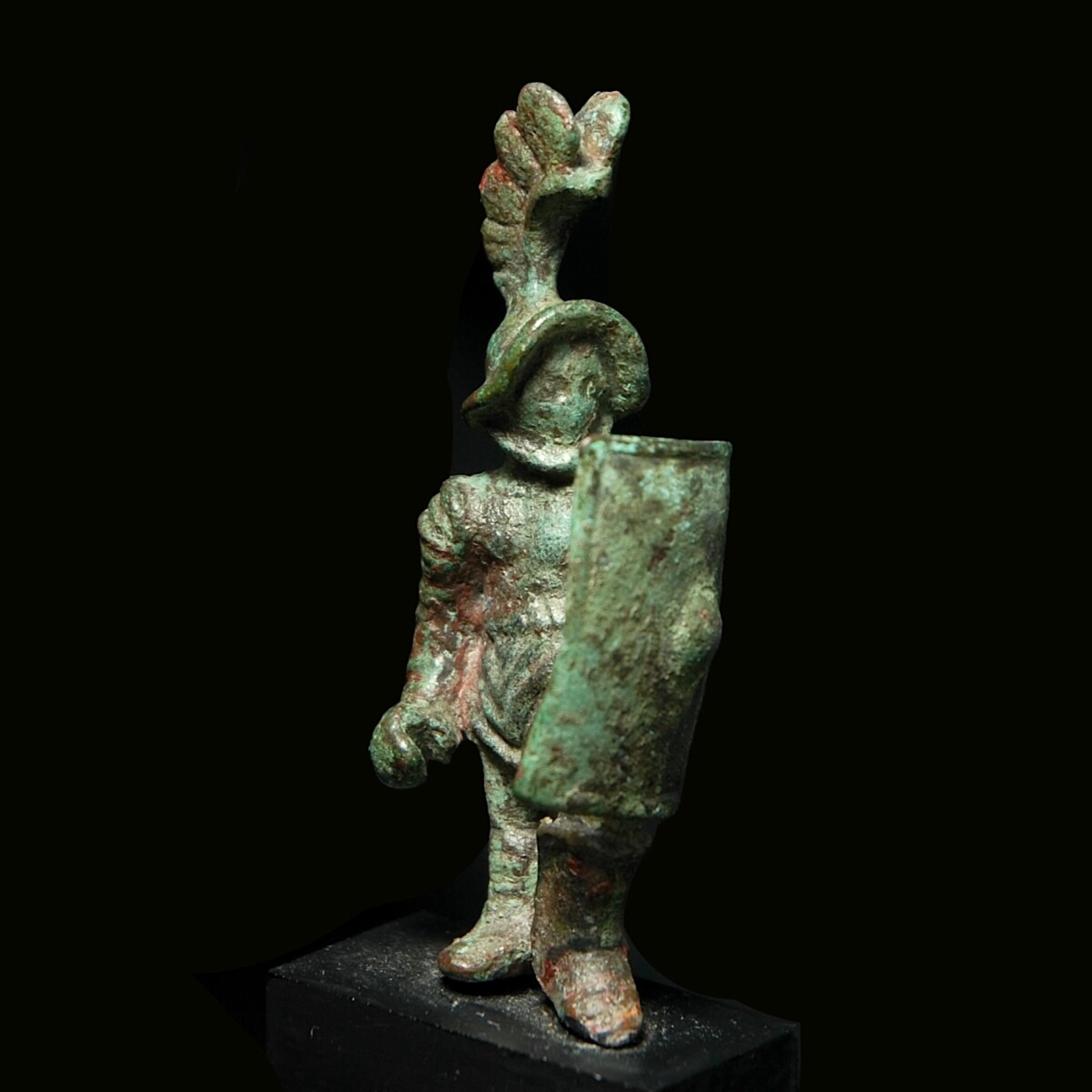
|
|
|
|
|

|
|
Roman Empire – 1st-2nd century A.D.
|
Solid bronze statuette of a murmillo. The gladiator wears a cassis crista, the full helmet with an extremely high crest decoration, broad rim and grill face visor. Around the belly the apron is tied with a broad belt. In his left hand he holds the rectangular, large shield of a Roman legionnaire (scutum). The right arm, including the hand, is protected by a thick, cross corrugated manica. Below the left knee he wears the ocrea (shin guard) for protection of the front leg. In the right hand the figure once held the today missing, separately worked out gladius. The name murmillo derives from "murma", a sea fish, which was caught with nets. The murmillo was originally used primarily against a gladiator with a net, the retiarius. Mounted.
|
Provenance: From the estate of the New York art dealer Edward H. Merrin, acquired in the 1990s from Royal Athena Gallery in New York.
Dimensions: 7.6 cm high
|
|
|
Römisches Reich – 1.-2. Jahrhundert n. Chr.
|
Vollbronze-Statuette eines Murmillos. Der Gladiator trägt einen Cassis Crista, den Vollhelm mit extrem hoher Krestzier, breitem Rand und vergittertem Visier. Um den Bauch ist der Schurz mit einem breiten Gürtel gebunden. In der Linken hält er den rechtwinkeligen, großen Schild der römischen Legionäre (Scutum). Der rechte Arm ist einschließlich der Hand von einer dicken, quergerippten Manica geschützt. Unterhalb des linken Knies trägt er zum Schutz des vorderen Beins die Ocrea, die Beinschiene. In der Rechten hielt die Figur einst einen heute verlorenen, separat gearbeiteten Gladius. Der Name Murmillo leitet sich von „Murma“ ab, einem Seefisch, der mit Netzen gefangen wurde. Der Murmillo wurde nämlich ursprünglich vor allem gegen einen Gladiator eingesetzt, der mit einem Netz bewaffnet war, den Retiarius. Gesockelt.
|
Provenienz: Aus dem Nachlass des New Yorker Kunsthändlers Edward H. Merrin, erworben in den 1990er Jahren von Royal Athena Gallery in New York.
Höhe: 7,6 cm
Preis: 9.000 Euro
|
|
|
|
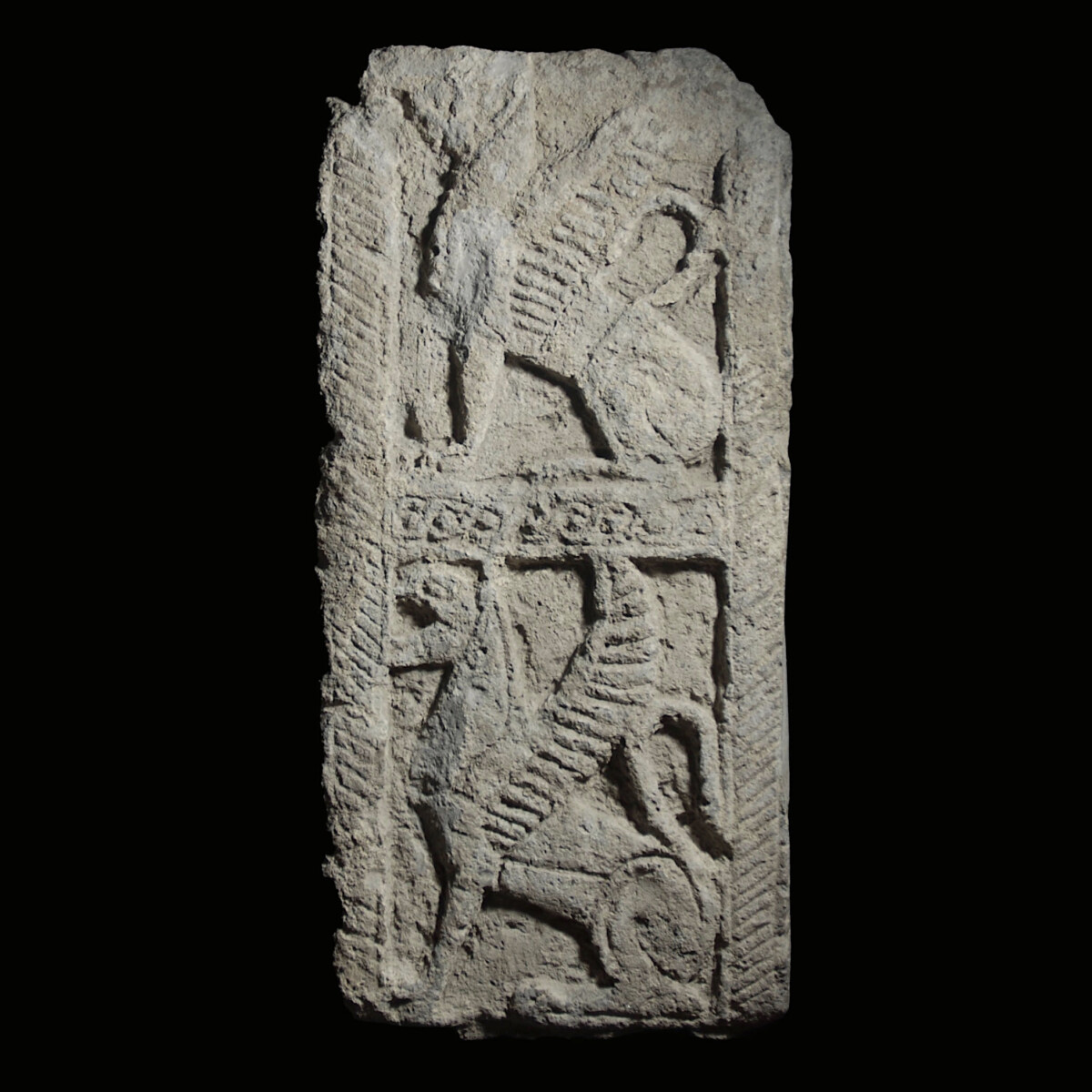
|
|
|
|
Etruria – Early 6th century B.C.
|
Large relief of volcanic Nenfro tuff which belonged to a stair slab relief (“Lastrone a Scala”). This earliest evidence of Etruscan sculptures and relief art from Tarquinia possibly served as door clasps of chamber tombs. The image areas lying one above the other show two griffins sitting upright to the left. They probably serve as grave guards and have their wings erect and their raised tail turned outwards. The griffins are separated by a braided band. Right and left fluted strips, which intend to imitate twisted ribbons. At the break on the left side were the sculptural stairs, which owe the stair slab relief its name. See for reference the stair slab relief in the Museum für Kunst und Gewerbe Hamburg with the inventory number 1999.280, as well as the relief in the Museo archeologico nazionale in Tarquinia. On an old metal base.
|
Provenance: From an old Swiss collection. Thence Belgian private collection, acquired 1988 in the gallery Elsa Bloch-Diener in Bern, Switzerland. Last in the French art market. With a copy of the invoice.
Dimensions: 74.3 cm high
Price: 12 000 Euro
|
|
|
Etrurien – Anfang 6. Jahrhundert v. Chr.
|
Großes Relief aus vulkanischem Nenfro-Tuffstein, das zu einem Treppensteinrelief („Lastrone a Scala“) gehörte. Diese frühesten Zeugnisse der etruskischen Skulptur und Reliefkunst aus Tarquinia dienten wohl als Türverschlüsse von Kammergräbern. Die übereinander liegenden Bildflächen zeigen zwei aufrecht sitzende Greifen nach links. Sie dienen wohl als Grabwächter und haben die Flügel aufgerichtet und den angehobenen Schwanz nach außen gedreht. Die Greifen sind von einem Flechtband getrennt. Rechts und links geriffelte Leisten, die aufgedrehte Bänder imitieren sollen. An der Bruchstelle links schlossen die plastischen Treppen an, die den Treppensteinreliefs ihren Namen verdanken. Vergleiche dazu das Treppensteinrelief im Museum für Kunst und Gewerbe Hamburg mit der Inventarnummer 1999.280 sowie die Reliefs im Museo archeologico nazionale in Tarquinia. Auf altem Metallsockel.
|
Provenienz: Aus alter Schweizer Sammlung. Danach belgische Privatsammlung, erworben 1988 in der Galerie Elsa Bloch-Diener in Bern. Zuletzt im französischen Kunsthandel. Mit Kopie der Rechnung.
Höhe: 74,3 cm
Preis: 12.000 Euro
|
|
|
|
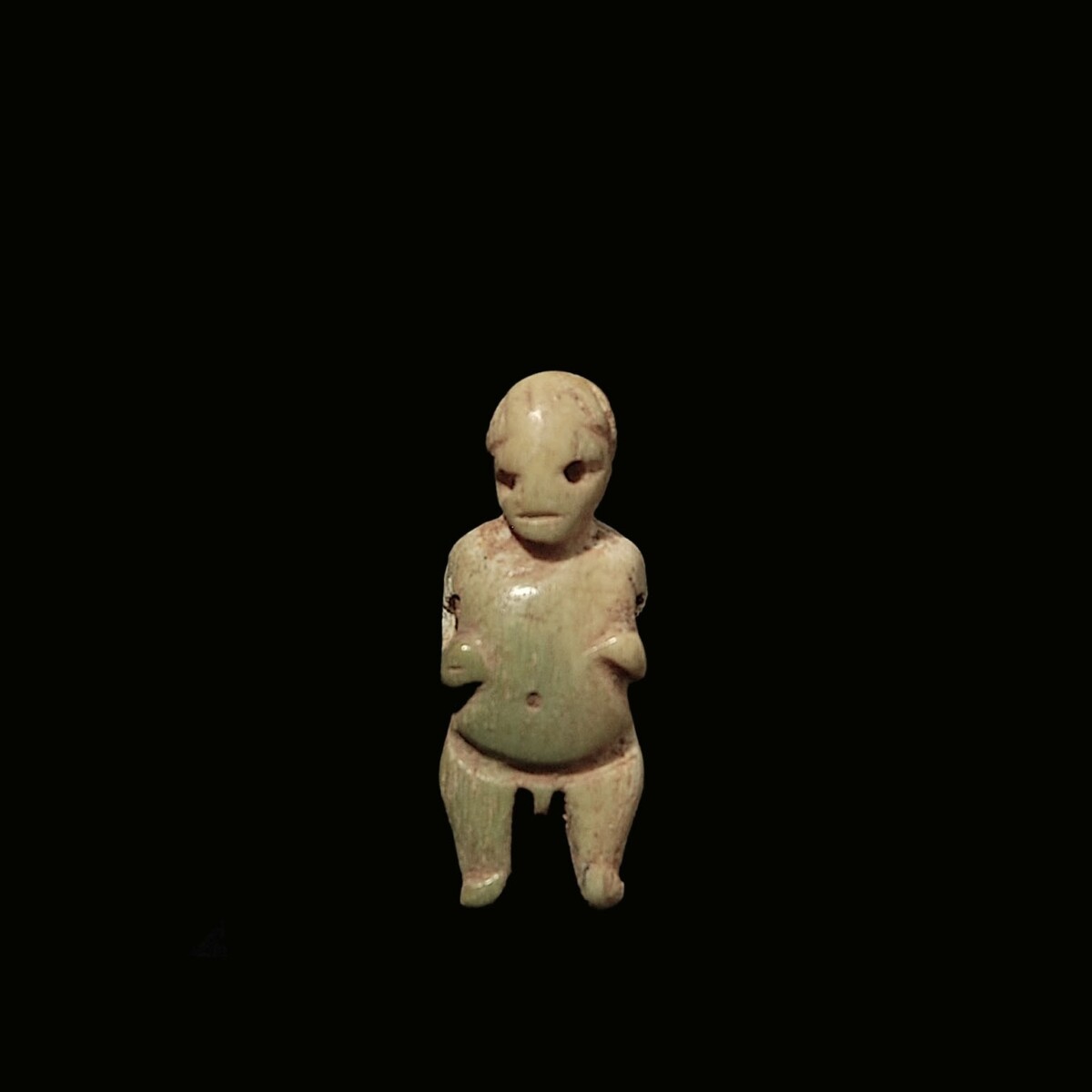
|
|
|
|
|
|
Bering Strait – 1000-1200 A.D.
|
Rare and in details worked out amulet of walrus ivory depicting a naked man with a round belly. The figure with a large head with clinging, thick hair strands and deeply pierced eyes, which possibly once held inlays. The arms are bent on the sides, the hands resting on the belly. The short legs with broad upper thighs are spread, between the private part. Fingers and toes are indicated with one engraving each. On the back the buttocks, shoulder blades and spinal column are engraved. The figure is horizontally pierced through the shoulder and could be worn as an amulet. Possibly with apotropaic meaning. The rare amulet belongs to the culture of the Punuk or Thule, who belong to the old Bering Strait culture, who left numerous important archaeological sites especially on St. Lawrence Island. St. Lawrence Island is located on the trail of walruses, whales, robes and countless bird species and offered in ancient times vital resources amid the otherwise rough Arctic environment. See for the type the figure from the Amy and Elliott Lawrence collection, auctioned with Sotheby's New York on 24 May 2022, lot 21. Mounted.
|
Provenance: From the French collection of the well-known art dealer Jean-Philippe Mariaud de Serres (1944-2007).
Dimensions: 3 cm high
|
|
|
Beringstraße – 1000-1200 n. Chr.
|
Seltenes und detailreich gearbeitetes Amulett aus Walross-Elfenbein, das einen nackten Mann mit rundem Bauch zeigt. Die Figur mit großem Kopf mit anliegenden, dicken Haarsträhnen und tief gelochten Augen, die wohl einst Einlagen trugen. Die Arme sind seitlich abgewinkelt, die Hände liegen am üppigen Wamst auf. Die kurzen Beine mit breiten Oberschenkeln sind gespreizt, dazwischen das männliche Geschlecht. Finger und Zehen sind durch je eine Gravur angedeutet. Auf der Rückseite sind Gesäß, Schulterblätter und Wirbelsäule graviert. Die Figur ist horizontal durch die Schulter gelocht und konnte so als Amulett getragen werden. Wohl mit apotropäischer Bedeutung. Das seltene Amulett gehört zur Kultur der Punuk oder Thule, die der alten Beringstraßen-Kultur angehören, die vor allem auf der Sankt-Lorenz-Insel zahlreiche bedeutende archäologische Stätten hinterließ. Die Sankt-Lorenz-Insel liegt am Wanderweg von Walrossen, Walen, Robben und unzähligen Vogelarten und bot schon in der Antike lebenserhaltende Ressourcen inmitten einer ansonsten rauen arktischen Umwelt. Vergleiche zum Typus die Figur aus der Amy und Elliott Lawrence-Sammlung, versteigert bei Sotheby’s New York am 24. Mai 2022, Los 21. Gesockelt.
|
Provenienz: Aus der französischen Sammlung des bekannten Kunsthändlers Jean-Philippe Mariaud de Serres (1944-2007).
Höhe: 3 cm
Preis: 2.600 Euro
|
|
|
|
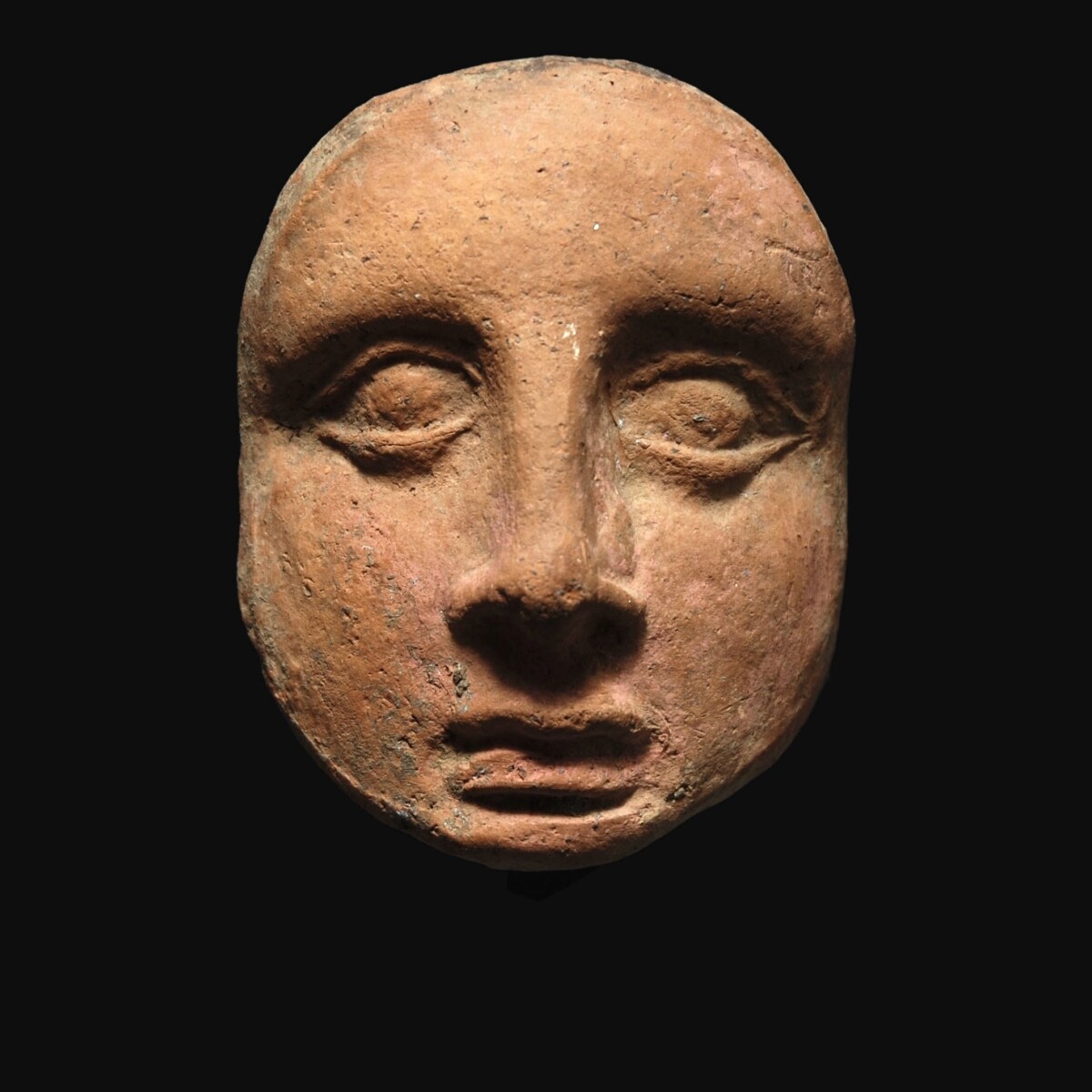
|
|
|
|
|
|
Etruria – 3rd-2nd century B.C.
|
Votive offering in form of a sculptural, smaller-than-life size face with naturalistic features formed out of the mold. The deep sitting eyes looking vigilantly out from thick lids. Iris and pupils are recognizable. The nose is straight and finely drawn, the mouth with its bulging lips slightly open. The surface still has beautiful rose color remains, which lends a human touch to the face. Especially during the Hellenistic period votive offerings to the gods, with anatomic details, were very popular in Etruria. One hoped for relief from physical suffering and expressed gratitude for healing that had already occurred. Face votive offerings such as the present one possibly represent a person who thus placed himself under divine protection. Mounted on a plexiglass base.
|
Provenance: Christie's auction from the 1980s, with an old label at the bottom of the stand. Thence in a New York collection and in the New York art market.
Dimensions: 11 cm high
Price: 1 400 Euro
|
|
|
Etrurien – 3.-2. Jahrhundert v. Chr.
|
Aus der Form gearbeitete Votivgabe in Form eines plastischen, unterlebensgroßen Gesichts mit naturalistischen Zügen. Die tief sitzenden Augen blicken wach hinter dicken Lidern hervor. Iris und Pupillen sind zu erkennen. Die Nase ist gerade und fein gezogen, der Mund mit seinen wulstigen Lippen leicht geöffnet. Die Oberfläche zeigt noch schöne rosa Farbreste, die dem Gesicht menschliche Hautfarbe verlieh. Gerade in hellenistischer Zeit waren Weihegaben an die Götter, die anatomische Details zeigten, in ganz Etrurien sehr beliebt. Man erhoffte sich davon Erlösung von körperlichen Leiden und sprach seinen Dank für die bereits erfolgte Heilung aus. Gesichtsvotive wie dieses standen womöglich auch für den ganzen Menschen, der sich so unter göttlichen Schutz stellte. Auf Plexiglasständer montiert.
|
Provenienz: Christie’s-Auktion aus den 1980er Jahren, mit altem Etikett auf der Unterseite des Standes. Danach in einer New Yorker Sammlung und im New Yorker Kunsthandel.
Höhe: 11 cm
Preis: 1.400 Euro
|
|
|
|
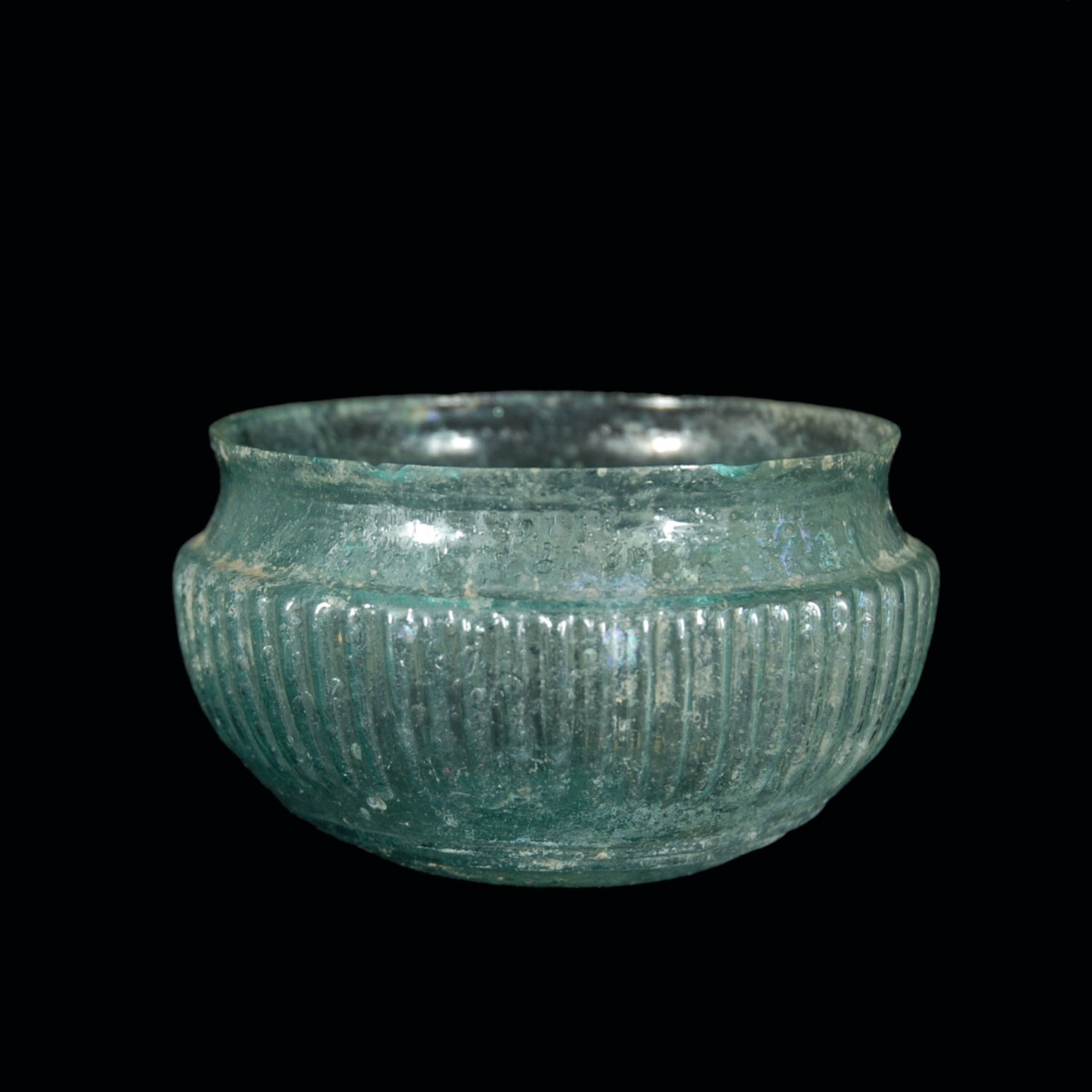
|
|
Roman Empire – 1st century A.D.
|
Finely worked out bowl of light green, transparent glass with encircling ribs. The bowl stands on a concave base, which is framed by two sculptural, circular ribs on the outside. Inside an omphalos. The wall with the ribs is curved outwards, the shoulder indented, the neck is slightly curved inwards. The rim is smoothly ground. Vessels such as the present one with fine rib decoration were possibly produced in Italy. See for the type "Römisches, byzantinisches und frühmittelalterliches Glas – Sammlung Ernesto Wolf", Hatje Cantz 2001, number 55.
|
Provenance: French private collection Michel Peytel (1919-1973), who kept his collection in his city palais ("Hôtel particulier") at Place Vendôme in Paris.
Dimensions: 8.8 cm in diameter; 5.1 cm high
Price: 4 000 Euro
|
|
|
Römisches Reich – 1. Jahrhundert n. Chr.
|
Fein gearbeitete Schale aus blassgrünem, durchsichtigem Glas mit umlaufenden Rippen. Die Schale steht auf einem konkaven Boden, der außen von zwei plastischen Kreisrippen umgeben ist. Innen ein Omphalos. Die Wandung mit den Rippen nach außen gewölbt, die Schulter eingezogen, der Hals leicht nach innen gewölbt. Der Rand ist überschliffen. Gefäße wie dieses mit feinem Rippendekor wurden wohl in Italien hergestellt. Vergleiche zum Typus „Römisches, byzantinisches und frühmittelalterliches Glas – Sammlung Ernesto Wolf", Hatje Cantz 2001, Nummer 55.
|
Provenienz: Französische Privatsammlung Michel Peytel (1919-1973), der seine Sammlung in seinem Stadtpalais („Hôtel particulier“) am Pariser Place Vendôme aufbewahrte.
Durchmesser: 8,8 cm; Höhe: 5,1 cm
Preis: 4.000 Euro
|
|
|
|
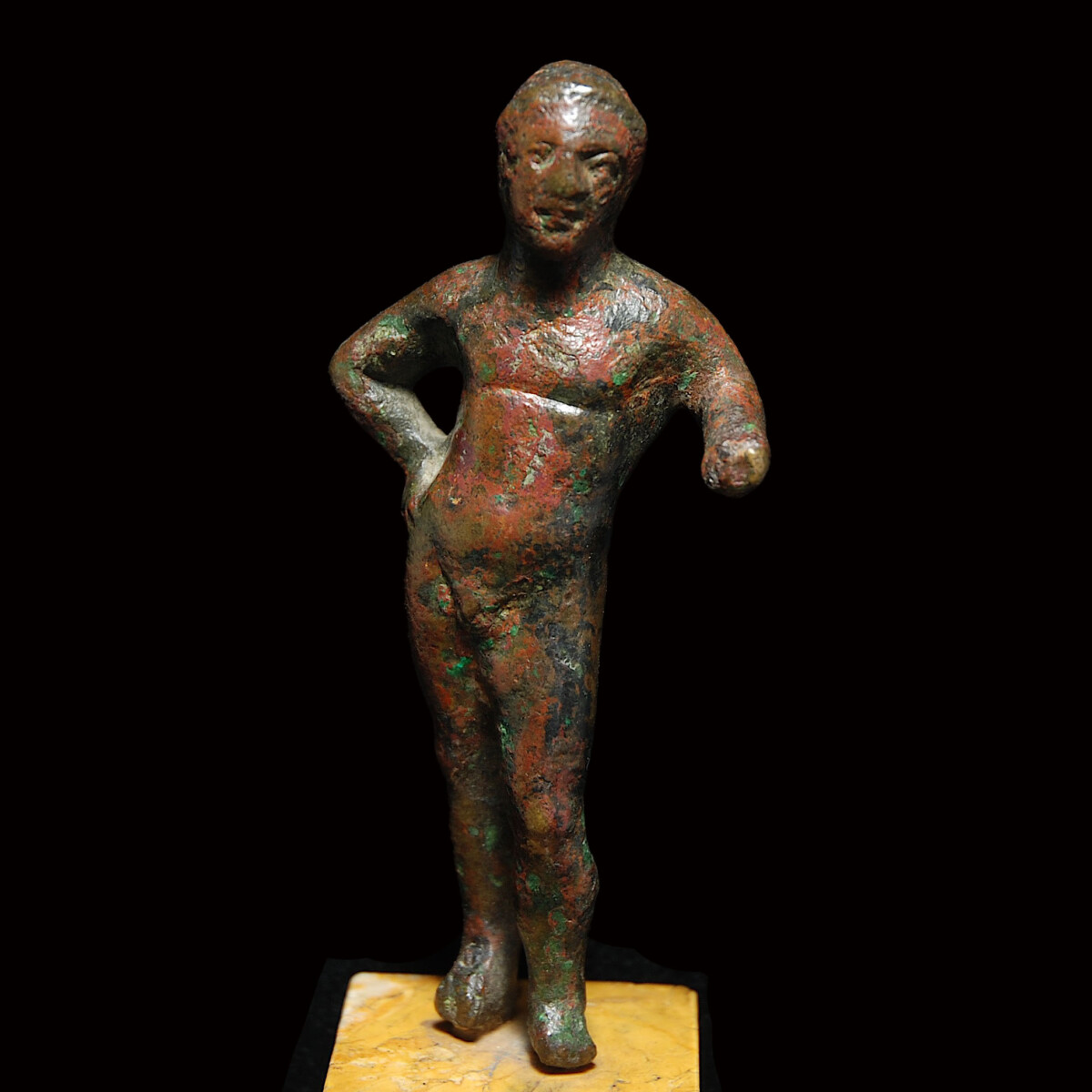
|
|
|
|
|
|
Greece – 2nd-1st century B.C.
|
Solid cast bronze statuette of an unclothed Heracles in contrapposto. The god stands with his weight on the right leg, the left free leg slightly bent forward. He has his right arm pushed against his hip, his left arm, with remains of the fur of the Nemean lion still visible, is bent and put forward. He has short, wavy hair, which is held with a filet. On an old marble base.
|
Provenance: From the French private collection M. R., acquired in the early 1980s.
Dimensions: 10.8 cm high
Price: 1 200 Euro
|
|
|
Griechenland – 2.-1. Jahrhundert v. Chr.
|
Vollbronze-Statuette des unbekleideten Herakles im Kontrapost. Der Gott steht mit dem Gewicht auf seinem rechten Bein, das linke Spielbein leicht nach vorne abgewinkelt. Er hat seinen rechten Arm in die Hüfte gestemmt, seinen linken, auf dem noch Reste des Fells des Nemeischen Löwen zu erkennen sind, hat er abgewinkelt nach vorne gestreckt. Er hat kurzes, gelocktes Haar, das von einem Haarband zusammengehalten wird. Auf altem Marmorsockel.
|
Provenienz: Aus der französischen Privatsammlung M. R, erworben in den frühen 1980er Jahren.
Höhe: 10,8 cm
Preis: 1.200 Euro
|
|
|
|
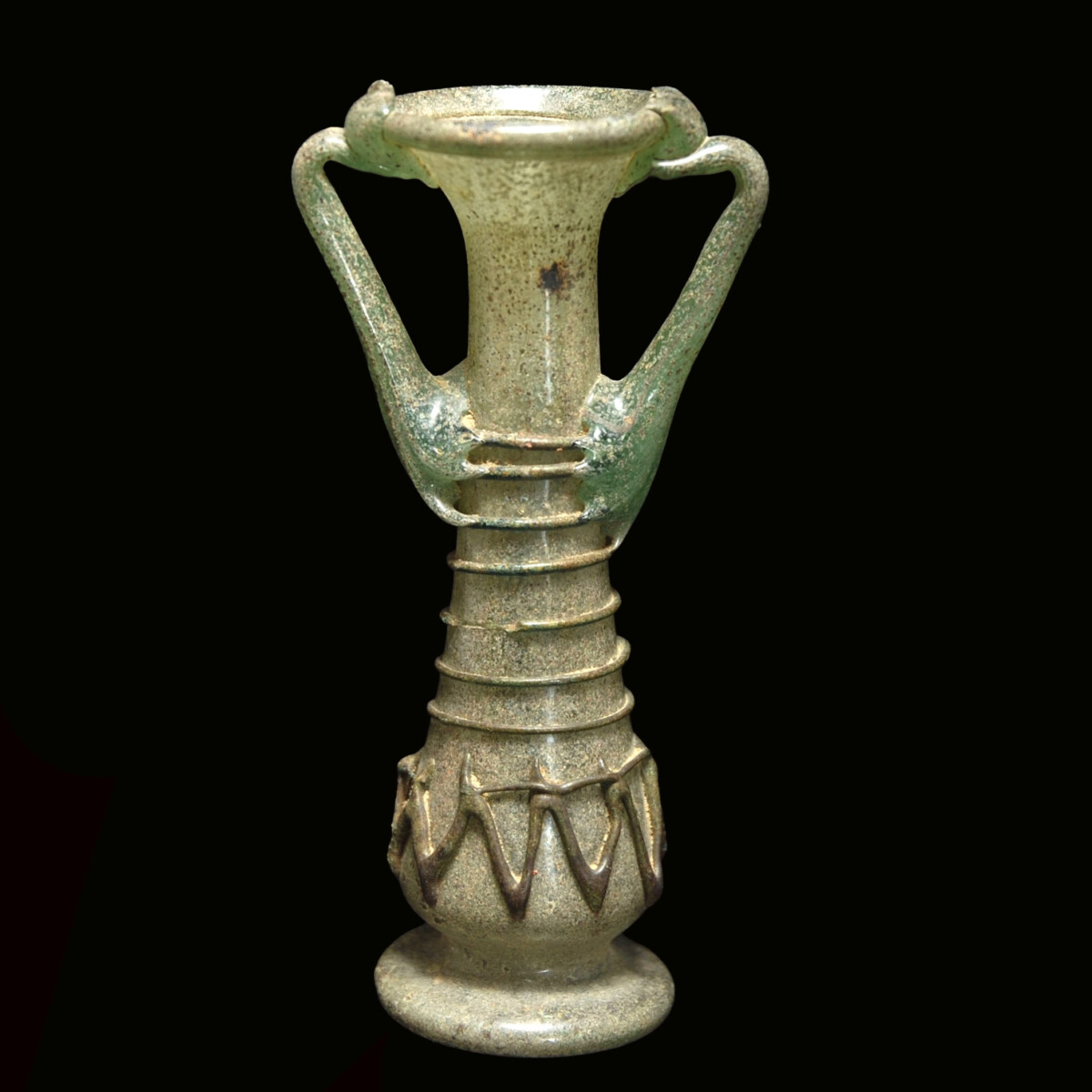
|
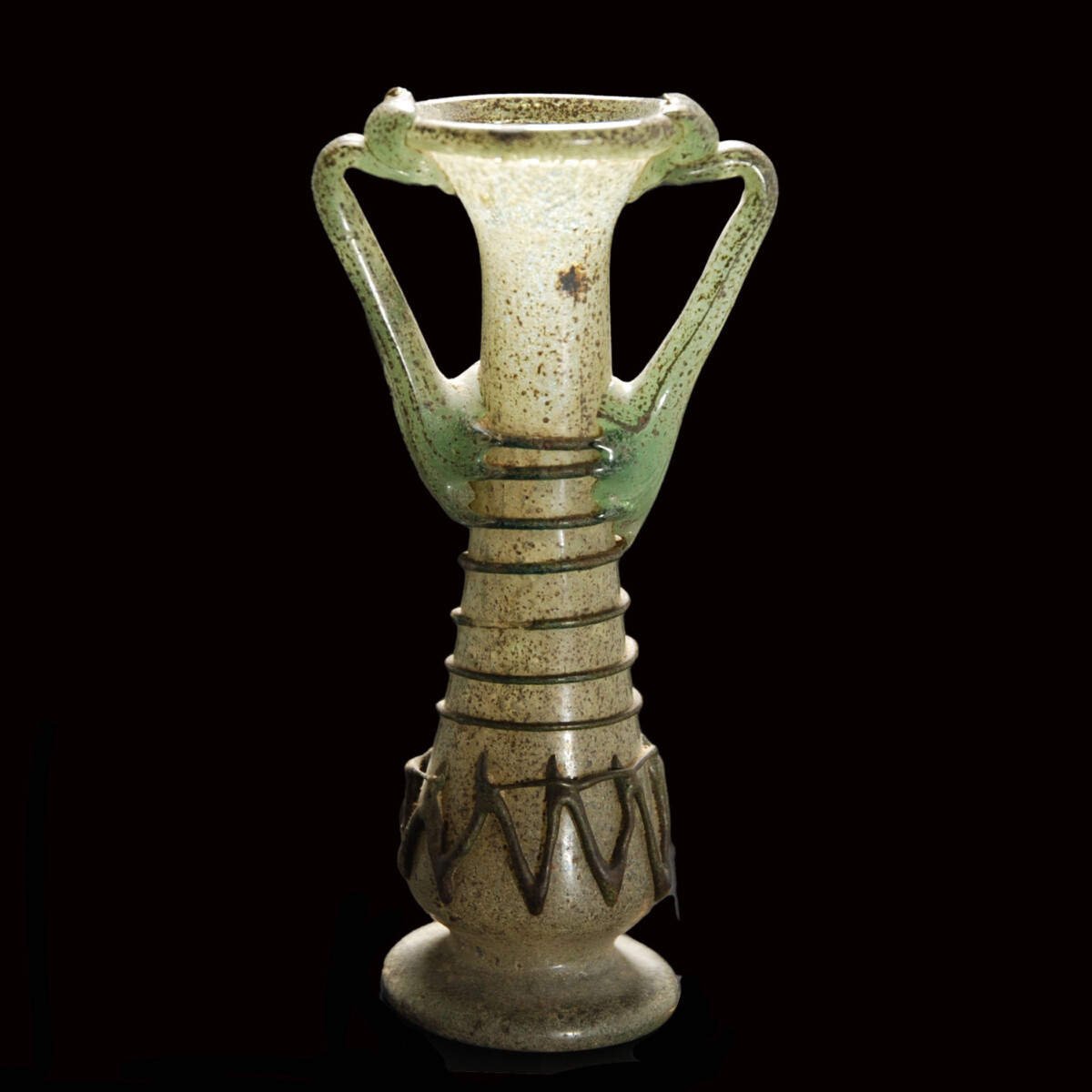
|
|
Roman Empire – Late 4th to early 5th century A.D.
|
Wunderbar erhaltene Parfumflasche aus Glas mit zwei Henkel. Die Flasche mit röhrenförmigem Körper, der sich nach unten verbreitert. Die Mündung weit nach außen gezogen und heiß abgerundet und verdickt. Am Rand setzen die Henkel an, die horizontal verlaufen und nach einem Knick steil zur Wandung abfallen. Dort, wo die Henkel am Korpus anliegen, ist ein feiner Glasdraht angesetzt, der spiralförmig nach unten verläuft. Seine letzte Windung ist zugleich die obere Begrenzung eines zweiten, dickeren Glasdrahtes, der in Zickzackform auf den Körper angesetzt ist. Das Gefäß steht auf einem abgesetzten Standring mit konkavem Boden. Aus Palästina. Vergleiche zur Form „Römisches, byzantinisches und frühmittelalterliches Glas – Sammlung Ernesto Wolf“, Hatje Cantz 2001, Nummer 143.
|
Provenance: Israeli collection Z. Holtzmann, Tel Aviv.
Dimensions: 12.2 cm high
Price: 1 200 Euro
|
|
|
Römisches Reich – Ende 4. bis Anfang 5. Jahrhundert n. Chr.
|
Wunderbar erhaltene Parfumflasche aus Glas mit zwei Henkel. Die Flasche mit röhrenförmigem Körper, der sich nach unten verbreitert. Die Mündung weit nach außen gezogen und heiß abgerundet und verdickt. Am Rand setzen die Henkel an, die horizontal verlaufen und nach einem Knick steil zur Wandung abfallen. Dort, wo die Henkel am Korpus anliegen, ist ein feiner Glasdraht angesetzt, der spiralförmig nach unten verläuft. Seine letzte Windung ist zugleich die obere Begrenzung eines zweiten, dickeren Glasdrahtes, der in Zickzackform auf den Körper angesetzt ist. Das Gefäß steht auf einem abgesetzten Standring mit konkavem Boden. Aus Palästina. Vergleiche zur Form „Römisches, byzantinisches und frühmittelalterliches Glas – Sammlung Ernesto Wolf“, Hatje Cantz 2001, Nummer 143.
|
Provenienz: Israelische Sammlung Z. Holtzmann, Tel Aviv.
Höhe: 12,2 cm
Preis: 1.200 Euro
|
|
|
|
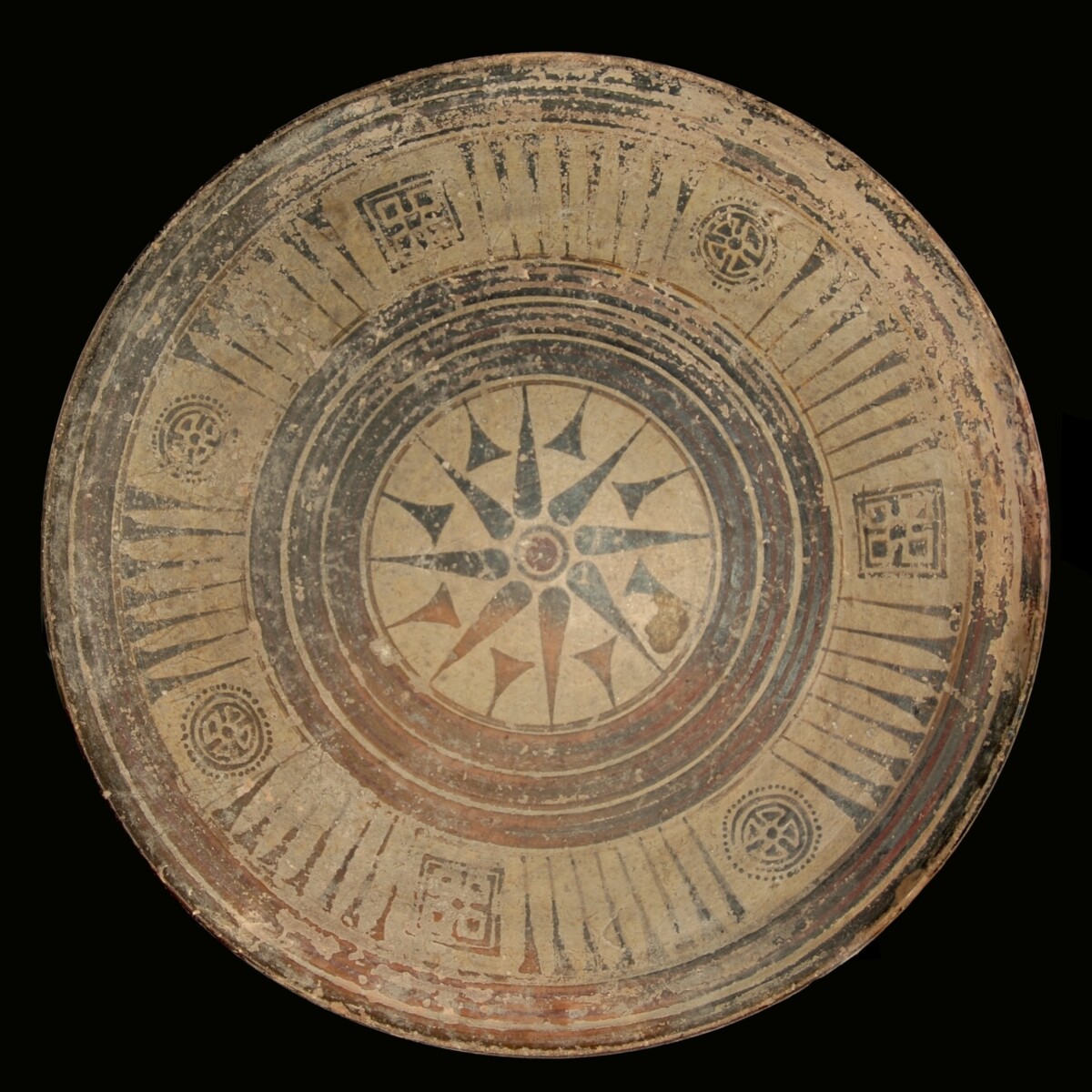
|
|
|
|
|
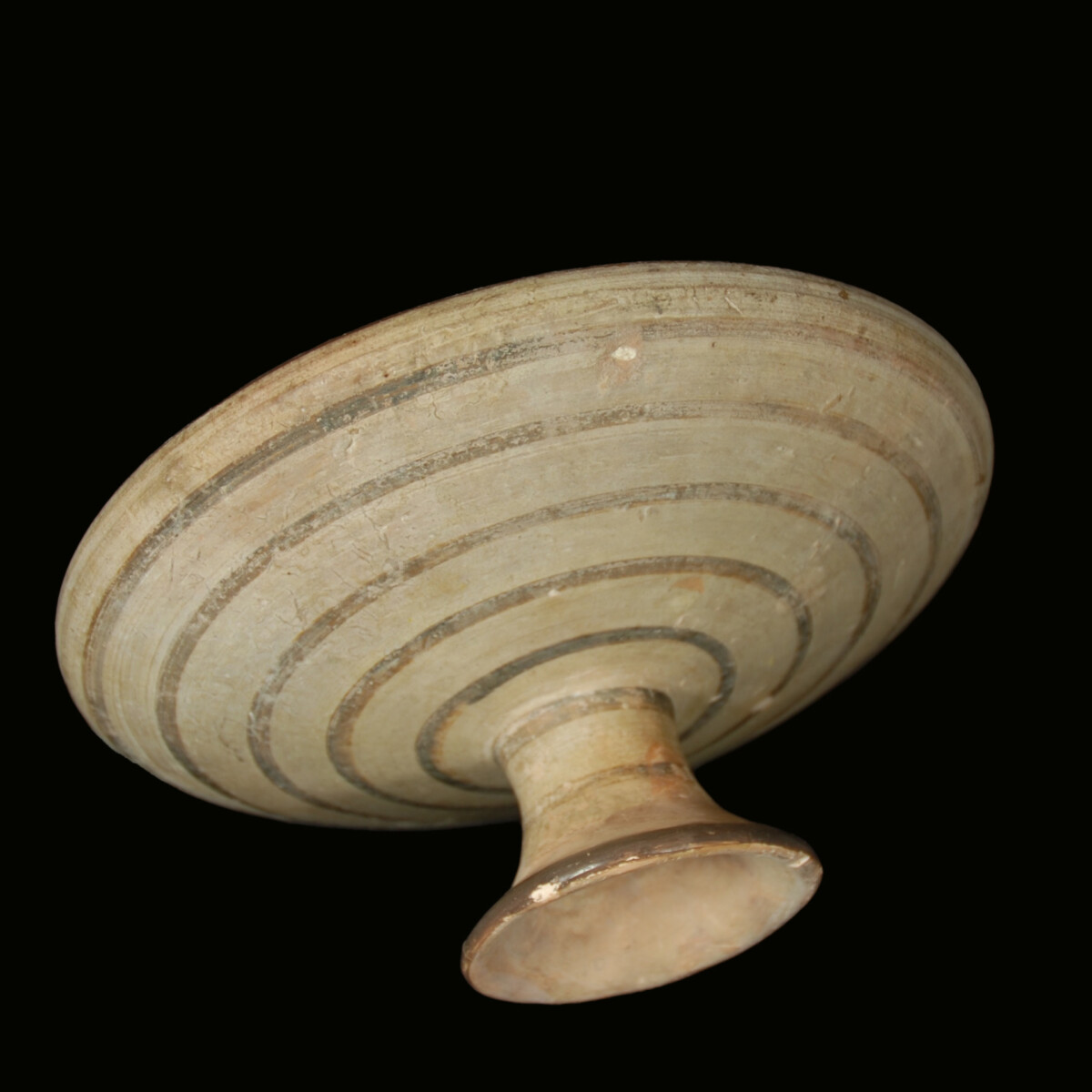
|
|
Greece/Rhodes – around 600 B.C.
|
Large terracotta footed bowl of the Wild Goat style from Kameiros on Rhodes. The vessel stands on a high, at the bottom far protruding foot, which is decorated with brown stripes and is surrounded by five concentric circles on the underside of the bowl. The inside is abundantly decorated with geometric patterns. In the tondo is a red dot, from where long and short wedges radiate. Followed by concentric circles. In the arch ray decoration, as well as rosettes with round and square rims. With an old collection label with the number 737. The Wild Goat style is named after the often-used motive of goats, but there are also only geometrically decorated ceramics, such as the present footed bowl. See for the type the bowls in the British Museum with the Accession Number GR 1860.4-4-5, as well as 1909,0409.I. More similar bowls are in the Museum of Fine Arts in Boston with the number 99.508 and in the Archaeological Museum of Rhodes.
|
Provenance: From the private collection of the chemist Prof. Hans Dahn (1919-2019), Switzerland. Acquired on 25 February 1953 from Ascher in Paris and registered with the number 65 in the collection. With a copy of the handwritten inventory list and the handwritten collection card.
Dimensions: 26 cm in diameter; 11 cm high
Price: 1 800 Euro
|
|
|
Griechenland/Rhodos – um 600 v. Chr.
|
Große Terrakotta-Fußschale des „Wild Goat“-Stils aus Kameiros auf Rhodos. Das Gefäß steht auf einem hohen, unten weit auslaufenden Fuß, der mit braunen Streifen verziert ist und auf der Unterseite der Schale von fünf konzentrischen Kreisen umgeben ist. Die Innenseite ist reich mit geometrischem Dekor verziert. Im Tondo ist ein roter Punkt, von dem sternförmig lange und kurze Keile abstehen. Daran anschließend konzentrische Kreise. In der Wölbung Strahlendekor sowie Rosetten mit runden und quadratischen Rändern. Mit alter Sammlungsetikette mit der Nummer 737. Der „Wild Goat“-Stil ist nach dem häufigen verwendeten Motiv von Ziegen benannt, es gibt jedoch auch rein geometrisch dekorierte Keramik wie unsere Fußschale. Typisch ist der cremefarbene Grundton und die bichrome Bemalung mit Dunkelbraun und Rot. Vergleiche zum Typus die Schalen im British Museum mit der Accession Number GR 1860.4-4-5 sowie 1909,0409.I. Weitere ähnliche Schalen befinden sich etwa im Museum of Fine Arts in Boston mit der Nummer 99.508 und im Archäologischen Museum von Rhodos.
|
Provenienz: Aus der Privatsammlung des Chemikers Prof. Hans Dahn (1919-2019), Schweiz. Erworben am 25. Februar 1953 bei Ascher in Paris und unter der Nummer 65 in die Sammlung aufgenommen. Mit Kopie der handschriftlichen Inventarliste und der handschriftlichen Sammlungskarte.
Durchmesser: 26 cm; Höhe: 11 cm
Preis: 1.800 Euro
|
|
|
|
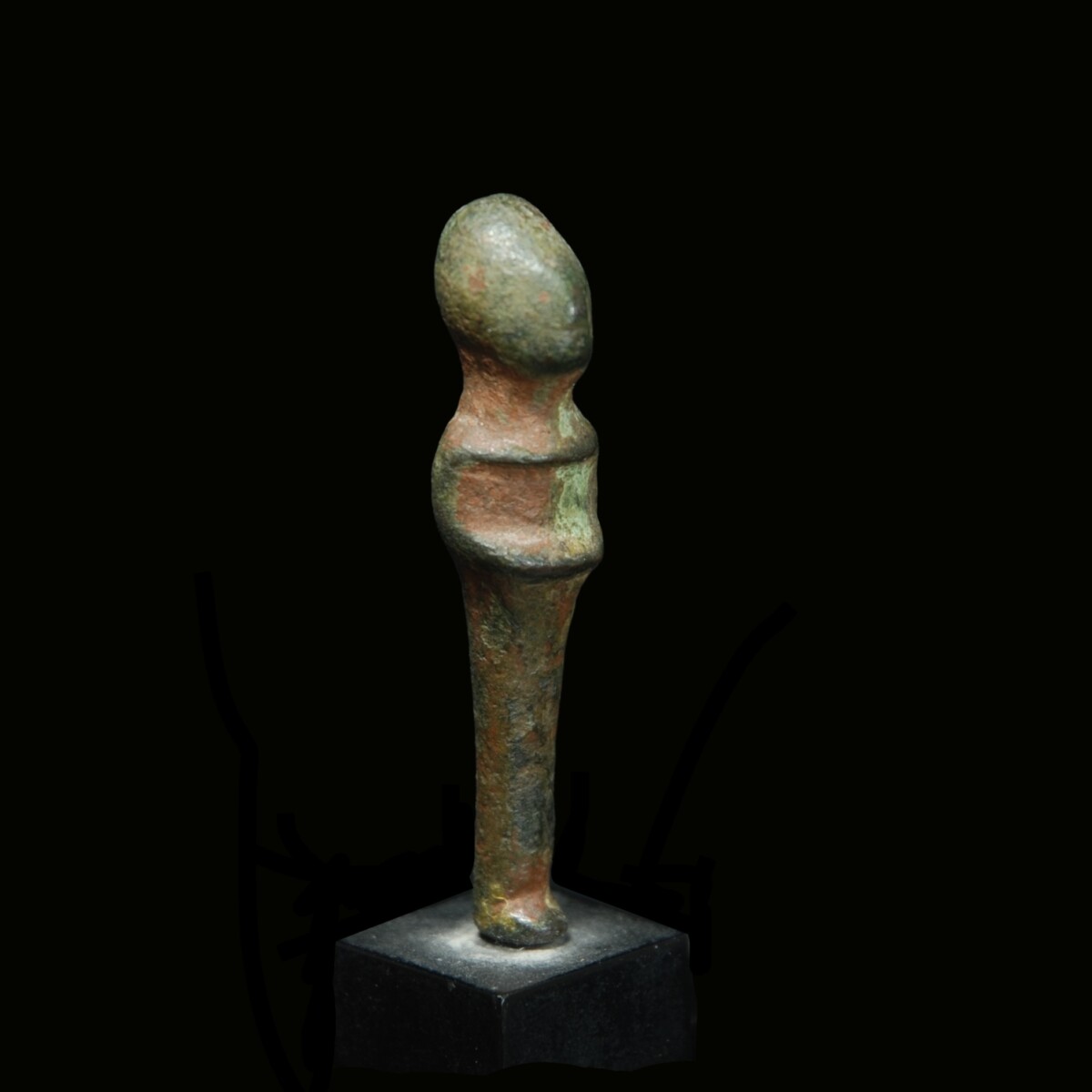
|
|
Iberian Peninsula – 4th-3rd century B.C.
|
Stylized solid bronze figure of a praying woman from a sanctuary of the Iberian Celts, possibly from Jaén. The woman wears a figure-hugging gown and her arms are placed in front of her chest. She has a high, on top rounded mitra on her head. The face is dominated by a pointy nose. On the flat back the bent upper arms are accentuated. See for the type the statuette in the Musée des Antiquités Nationales in Saint-Germain-en-Laye with the inventory number 77876.307, published in: “Die Iberer”, Bonn 1997, page 351, number 320. Mounted.
|
Provenance: Private collection Jean Deriat (1922-2016), Paris. Acquired in the gallery Bresset et fils in Paris on 7 October 1967. With the original certificate. Thence in a family estate.
Dimensions: 6 cm high
Price: 900 Euro
|
|
|
Iberische Halbinsel – 4.-3. Jahrhundert v. Chr.
|
Stilisierte Vollbronze-Figur einer betenden Frau aus einem Heiligtum der iberischen Kelten, wohl aus Jaén. Die Frau ist in ein enganliegendes Gewand gehüllt und hat ihre Arme vor die Brust gelegt. Sie trägt eine hohe, oben abgerundete Mitra am Kopf. Das Gesicht wird von der spitz zulaufenden Nase dominiert. An der flachen Rückseite sind die abgewinkelten Oberarme akzentuiert. Vergleiche zum Typus die Statuette im Musée des Antiquités Nationales in Saint-Germain-en-Laye mit der Inventarnummer 77876.307, publiziert in: „Die Iberer“, Bonn 1997, Seite 351, Nummer 320. Gesockelt.
|
Provenienz: Privatsammlung Jean Deriat (1922-2016), Paris. Erworben in der Galerie Bresset et fils in Paris am 7. Oktober 1967. Mit Original-Zertifikat. Danach in Familienbesitz.
Höhe: 6 cm
Preis: 900 Euro
|
|
|
|
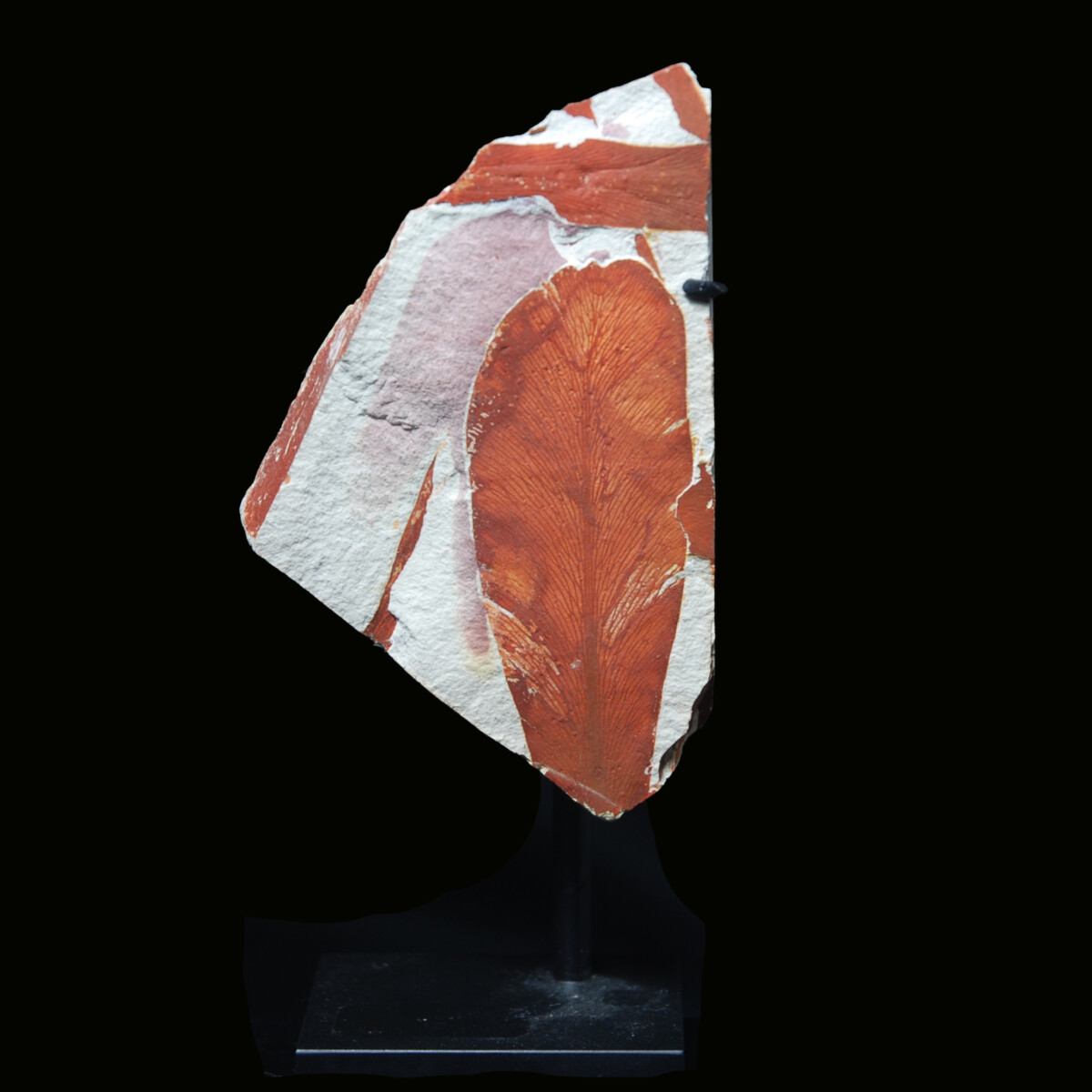
|
|
|
|
Gondwana – Permian period, 260 million years before our time
|
Magnificently preserved leaf of the extinct plant genus Glossopteris, which widely flourished during the Perm period in the south continent Gondwana. The name originates from the tongue-shaped leaves (“glossis” Greek for tongue, as well as “pteris” for “fern”). The leave is typically lanceolate and has a prominent midrib, as well as a fine net venation. It possibly is the subspecies Glossopteris browniana, whose leaves have a round tip. It is considered that Glossopteris grew in dendriform and had thick wood. Due to the wide spread on the southern hemisphere the plant genus was an important evidence for the theory of the continental drift and the existence of the supercontinent (“Gondwana”). Found in Dunedoo, New South Wales, Australia. On a custom-made metal base.
|
Provenance: Belgian private collection.
Dimensions: 9.8 cm high
Price: 800 Euro
|
|
|
Gondwana – Perm, 260 Millionen Jahre vor unserer Zeit
|
Prachtvoll erhaltenes Blatt der ausgestorbenen Pflanzengattung Glossopteris, die im Perm auf dem Südkontinent Gondwana weit verbreitet war. Der Name kommt von den zungenförmigen Blättern („glossis“ griechisch für „Zunge“ sowie „pteris“ für „Farn“). Das Blatt ist typisch lanzettförmig und besitzt eine ausgeprägte Mittelrippe sowie eine feine Netznervatur. Es handelt sich hier wohl um die Unterart Glossopteris browniana, deren Blätter eine runde Spitze aufweisen. Man geht davon aus, dass Glossopteris baumförmig wuchsen und ein dichtes Holz hatten. Aufgrund der weiten Verbreitung auf der Südhalbkugel war diese Pflanzengattung ein wichtiger Beweis für die Theorie der Kontinentalverschiebung und die Existenz eines gewaltigen Südkontinents ("Gondwana"). Gefunden in Dunedoo, New South Wales, Australien. Auf maßgeschneidertem Metallsockel.
|
Provenienz: Belgische Privatsammlung.
Höhe: 9,8 cm
Preis: 800 Euro
|
|
|
|
|
|
|
CHRISTOPH BACHER ARCHÄOLOGIE ANCIENT ART GmbH
|
Galerie: Stubenring 20, A-1010 Wien
Showroom: Untere Viaduktgasse 55, A-1030 Wien
|
|

|
|
|
|




